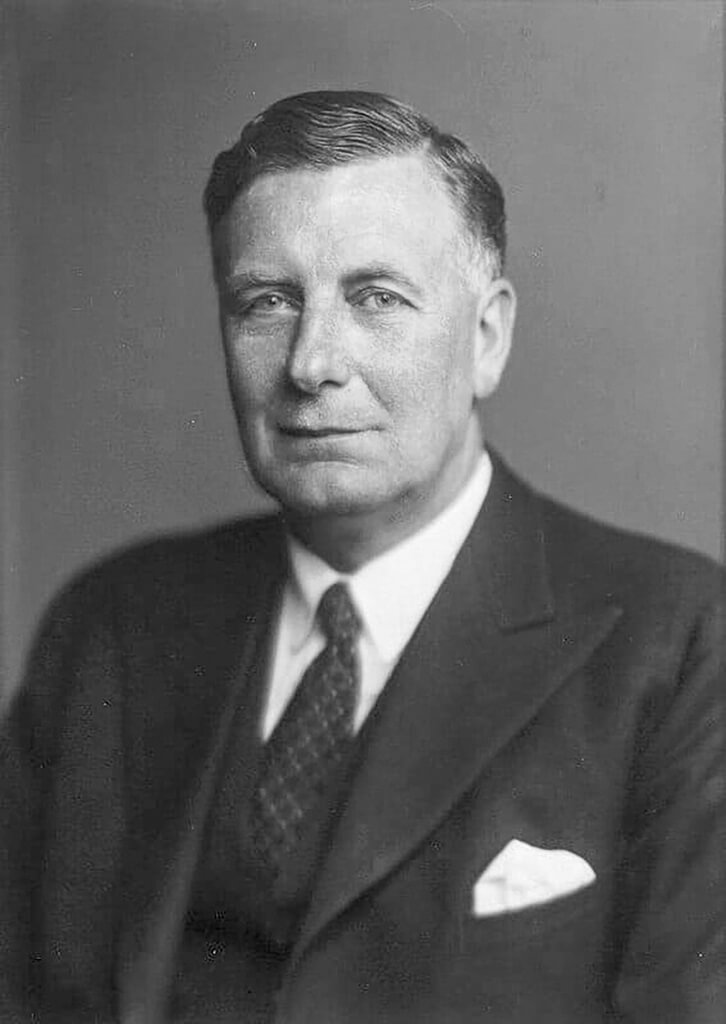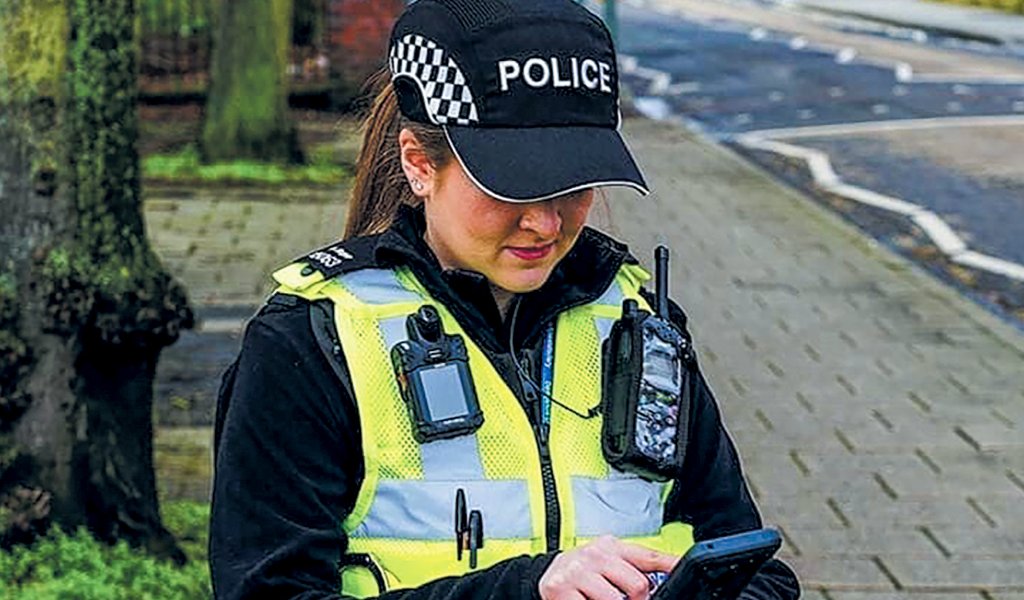Patrick Coleman looks at the remarkable legacy of a former chief constable of the Chesterfield Police Force.
A CHEQUERBOARD of black and white squares – ‘dicing’ as the design is properly known – is an instantly recognisable symbol of British policing, known the world over. The pattern has adorned uniforms, police cars and stations, and been adopted by forces as far away as Chicago and New Zealand.

Even so, and despite its ubiquity, few people are aware of how or when the famous design originated, nor of its originator’s connection to Derbyshire. But ‘Sillitoe Tartan’ – as the pattern is affectionately nicknamed – was the brainchild of one Sir Percy Sillitoe, a remarkable police officer, later Director General of MI5, whose first-ever posting as a UK officer had been as Chief Constable of Chesterfield Borough Police!
Born in London in 1888, Sillitoe had left Britain at the tender age of 20, heading to Africa to take up an opportunity in the colonial police forces of the then British Empire. He served in the British South Africa Police and then the Northern Rhodesia Police, in what is now Zambia. He was there when the First World War broke out in 1914, shaking the Empire.
The young Sillitoe was drawn into the East Africa campaign, where German colonial forces began attacking British interests, hoping to divert UK troops and resources away from the war in Europe. Although the campaign finally went Britain’s way, and Sillitoe escaped the conflict unscathed, he was still forced to step back from colonial duties in 1922 after contracting rheumatic fever, being forced to return to Britain.
It was back in England, and with no previous British policing experience that Sillitoe – to his surprise – was appointed to a Chief Constable position in a major force. His war service had been better reported that he had suspected, and though initially worried he would not find work back home, he found himself deployed to the senior role in north Derbyshire, leading Chesterfield Police. Although Sillitoe was only to be Chief Constable here for a short tenure of two years, he had a big impact on the town’s policing. Not only did he instigate a full reorganisation of the force, but he convinced the local authorities to build the town a new Police and Fire Station. These were constructed on New Beetwell Street and opened in 1926, and extended in 1937.
Sillitoe moved over the county border next, first to East Riding, then to Sheffield and finally heading to Glasgow. In these two cities, Sillitoe became famous for helping break the power of notorious criminal gangs. The Sheffield gangs may not be as well-known as Birmingham’s ‘Peaky Blinders’, but the city’s Gang Wars were just as dark and violent (giving rise to Sheffield’s nickname, ‘Little Chicago’).
“The peaked cap, which would become the main showpiece for Percy Sillitoe’s iconic design has, however, a more ‘chequered’ history.”
Sillitoe set up a Special Duties Squad to crack the gangs. He was so successful that he was drafted to Glasgow to deal with the notorious ‘Razor Gangs’, which began to fracture in the years before the Second World War, thanks to Sillitoe’s ‘reasonable force’ approach.
It was in Glasgow that Sillitoe made his enduring – though little celebrated – contribution to policing. Oddly, it was a sartorial one (and a compulsory sartorial one at that, making Sillitoe something of a “fashion police” officer).
Police uniforms have undergone many changes through their history. The original ‘Bobbies’ of the Metropolitan Police had worn civilian-style dress. Sir Robert Peel, the founder of modern policing, wanted to distinguish his new officers from soldiers, so suspicious were the public of a centrally controlled, government-backed police force. Instead of military attire, the new police wore civilian frock coats and ‘stovepipe’ top hats, while in place of military red, their clothing was made primarily blue. Until the Bobbies first appeared in 1829, the public had been used to informal law enforcement by local parish men who would volunteer their time for a year as a local constable or watchman.
The idea of a professional, organised ‘force’ was reminiscent to many of French-style secret police, and so Bobbies were at pains to appear less official. It wasn’t long, however, before the uniform began to take on a more military feel, mainly because most Chief Constables were former soldiers who liked the idea of glistening badges and regimental insignia. The iconic ‘custodian helmet’, so familiar as a mark of British policing, appeared in 1863, a design thought to be based on Prussian military helmets. The ‘Brunswick Star’ badge on the front of the helmet was not adopted by all forces immediately, but was finally standardised in 1933.
The peaked cap, which would become the main showpiece for Percy Sillitoe’s iconic design has, however, a more ‘chequered’ history. Forms of it had been used by various forces throughout the 19th and early 20th centuries. And today, they are a far more common sight than the custodian helmet. It was in 1932 that Sillitoe introduced the black-and-white dicing band to the peaked caps of the City of Glasgow Police.
The accessory was in some ways a new form of the black-and-white striped armbands that Bobbies had worn to identify themselves to the public as members of the police. But it also owed much to the dicing patterns used by various Scottish military regiments on their Glengarry bonnets. Sillitoe Tartan was quickly adopted by Scotland’s forces, but only spread through the rest of the UK from 1972 onwards. These days, all British police forces use Sillitoe Tartan on cap bands, women’s bowler hats and cravats, as well as on high-visibility jackets and, now, on baseball caps. (The blue-and-yellow ‘Battenburg Markings’ used on most police vehicles today are a 1990s adaptation of Sillitoe Tartan; versions are also used by other emergency services; red and yellow by the fire brigade, green and yellow by the ambulance service.)
Sir Percy – he was to be knighted in 1942 – was equally instrumental in more practical advances. His work to introduce wireless radio to police vehicles led to the gradual reduction and disappearance of police communication boxes, once a widespread sight on Britain’s streets. His pioneering spirit was probably what brought him to the attention of the nation’s spy agencies. In 1946, he was appointed Director General of the Security Service, better known as MI5.
Although successful in this post, his tenure was rocked by the defection of the British spies Guy Burgess and Donald Duart McClean to the Soviet Union. It became clear that MI5 had not been aware of the ‘Cambridge Five’ spy ring, a huge embarrassment for the service whose remit included the weeding out of double-agents. Sillitoe retired as Director General in 1953 with his reputation somewhat tarnished.
Nevertheless, Sillitoe was not one for a quiet retirement. He took on a private detective role, working to combat the trafficking of diamonds. In this endeavour he’d come full circle back to his formative years in Africa, his employer being the South African De Beers Diamond Corporation. This last act was a great success as Sillitoe managed to stop a diamond smuggling operation from Sierra Leone.
Percy Sillitoe died in Eastbourne in 1962. His Chesterfield station on New Beetwell Street sadly no longer stands, though the street remains the site of the town’s police headquarters. However, Sillitoe’s most prevalent memorial can be seen adorning today’s Derbyshire police uniforms, and the badge itself of Derbyshire Constabulary. The successor force to Chesterfield Borough features the ‘Sillitoe Tartan’ named for the man who once led local policing in the county’s famous market town.






